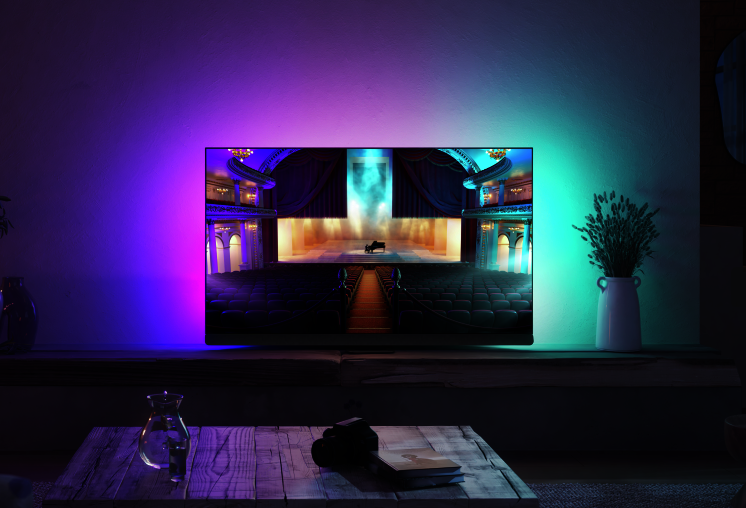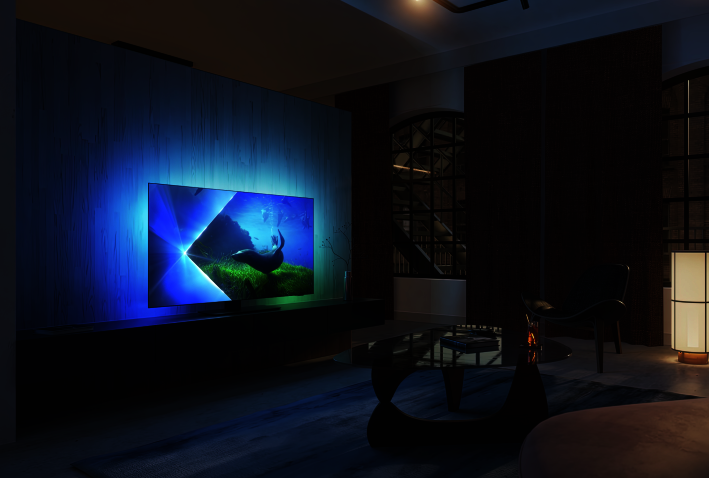Philips has lifted the lid on its premium TV lineup for 2023, announcing not one, but two very capable looking OLED models alongside a pair of new Mini-LED based displays.

Brighter, Sharper Images & Next-Level Gaming
The new OLED models include the flagship Philips OLED+908 (above) and Philips OLED808, and they boast an impressive number of firsts for the company. Regarding the more premium model of the two, one of the main highlights is the new “META OLED” display, which is based on LG Display’s recently announced Micro Lens Array technology and delivers the highest peak brightness of any OLED TV so far. According to Philips, the OLED+908 offers a potential peak light output of 2,100 nits, making it 70% brighter than previous generation OLED models, with superior viewing angles too.
Under the hood, the Philips OLED+908 will be one of the first TVs to be powered by the company’s latest 7th Gen P5 AI processor. The new chipset is likely to be the first in the world to be based on the recently announced MediaTek Pentonic 1000 processor, though Philips has yet to confirm this. Still, this is a big deal because it means the Philips OLED+908 and Philips OLED808 will be the first TVs running a MediaTek chipset that support 4K/120Hz Dolby Vision gaming. Until now, this feature was exclusive only to LG Electronics OLED TVs, which are based on an alternative chipset, so dedicated gamers finally have a viable alternative for ultra-smooth, lag-free graphics. That said, it's worth noting that the OLED+908 is unlikely to get more than two HDMI 2.1 ports, meaning that those who need more might be better served by LG's or Samsung's premium OLED offerings.
It's not only gamers who'll appreciate the new chip, as it offers further advances in terms of picture clarity. Philips explained that its superior processing power has enabled improvements to its Ambient Intelligence algorithm, allowing for the real-time adjustment of elements such as brightness, gamma and colour response to ensure more accurate pictures on screen. According to Philips, the Ambient Intelligence V2 algorithm employs a novel XYZ light sensor that’s able to detect the colour temperature of the ambient light in the room, in order to adjust the white point of on-screen images to match the natural tint. There’s also a new “Super Resolution” capability that helps to sharpen images at the edges of the screen, Philips said.
As always with Philips, the OLED+908 boasts a solid sound system too, with a 3.1 channel Bowers & Wilkins audio platform that sports six front-mounted drivers in a left, centre and right arrangement. Philips claims that this setup creates an “extra-wide soundstage” that’s supported by deep, accurate bass to deliver more immersive and realistic audio than previous models.
Philip’s signature three-sided Next Gen Ambilight system helps the TV stand out from the crowd, and it looks good in any case thanks to its stylish dark metal bezel that’s matched by a dark Kvadrat Audiomix cloth speaker grill and black sheen metal frame stand. Like most of Philips’ TVs these days, it runs the Google TV operating system.
New Capabilities For Philip’s Classic

The main differences between the Philips OLED+908 and the OLED808 are the OLED panel itself and the sound system. The OLED808 is fitted with an older “OLED EX” panel that debuted last year, and while it’s brighter than “standard” OLED displays, it doesn’t quite match the stunning luminescence promised by META OLED, with its peak brightness maxing out at around 1,000 nits, the company said.
That said, it’s still an excellent display and all the more so when we consider that the Philips OLED808 is going to be powered by the same, new 7th Gen P5 AI processor. In other words, it means gamers will have yet another viable option for Dolby Vision 4K 120Hz gaming at 48Gbps with FreeSync Premium and G SYNC compatibility, plus Auto Game and Auto Low-Latency modes. The three-sided Next Gen Ambilight system is also present, but sacrifices have been made with the sound system. The TV comes with an integrated, 70W 2.1 channel sound system that’s obviously somewhat less capable, though Philips tries to play up its ability to precisely control audio distribution across a pair of two-way left and right speakers and a dedicated, triple ring rear-facing bass driver.
The Philips OLED+908 will be available in three sizes - 55-inches, 65-inches and 77-inches - while the OLED808 will also have smaller 42-inch and 48-inch options when it goes on sale in the Autumn.
"The Xtra” Series TVs

As for the debutant “The Xtra” series TVs, these are said to be all about making Mini-LED technology more accessible. Philips promised a range of options to choose from, with the flagship offering being the 9308 MiniLED TV. It’ll be available in a choice of 55-inch and 65-inches and it too is powered by that 7th Gen P5 chipset. It boasts a 4K, 120Hz display that’s capable of 1,000 nits brightness and covers an impressive 98% of the DCI colour gamut, and it should produce some decent sounds too, thanks to the 64W, 2.1 channel Bowers & Wilkins sound system that’s built in.
It looks the part too thanks to the presence of Ambilight, and sports the same dark metal bezel and Kvadrat Audiomix fabric finish on the speaker grill that’s now become a signature of the Philips brand.
Last but not least, Philips announced a 9008 MiniLED TV that features the same chipset and panel and comes in an additional size of 75-inches, but once again compromises on the sound system.
Both of The Xtra TVs will launch in the third quarter of the year, Philips said.